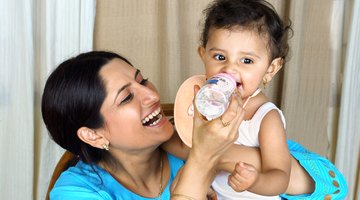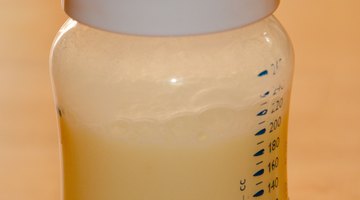When to Start Using Stage 3 Bottle Nipples
Whether you are feeding a baby formula or pumped breast milk from a bottle, you have plenty of choices to make among bottle nipples. One consideration when it comes to bottle feeding is when to start using a higher stage of nipple. Age isn't an exact determinant of when to go from stage 2 to stage 3 nipples, but some factors will point you toward the next stage.
All About Stages
Baby bottle nipples come in different stages. These indicate the size of the holes and how quickly the milk or formula flows through them. In general, as a baby gets older, you should provide her with larger stage nipples to accommodate her improving sucking ability and growing need for more milk per feeding. Most bottle nipples come with general guidelines on the package about when a baby is likely to be ready for each stage of nipples. However, because babies progress differently and have different needs, your child could be ready for a stage 3 nipple earlier or later than her peers.
Reasons to Move Up

How to Know When to Change Breasts While Breastfeeding
Learn More
If your baby is sucking strongly on stage 2 nipples and never seems satisfied with the speed of the flow, it might be time to move up to stage 3 nipples. Most babies start needing a stage 3 bottle nipple at about 6 months of age. If you switch to stage 3 nipples and your baby seems to be having trouble with the increased flow, you can switch back to stage 2 nipples for a while longer.
Reasons to Stay Down
Even if your baby is old enough for a stage 3 nipple, he might be better off sticking with a stage 2 nipple if he seems satisfied with the flow level. Some babies prefer the slower flow and never need to move to a stage 3 nipple; they often switch to a sippy cup when they get too big for a stage 2 nipple. Breastfeeding mothers might prefer to keep their baby on a lower nipple stage when feeding pumped milk or supplemental formula because the breasts release milk more slowly than a bottle nipple does. A breastfed baby could start refusing the slower-flowing breast in favor of the fast-flowing stage 3 bottle nipple.
More Considerations

Widening Baby Bottle Nipples
Learn More
A nipple that flows too quickly or too slowly for your baby can also increase the risk of air bubbles, leading to increase gassiness and an uncomfortable baby. In addition to the stage, nipples also have a variety of shapes from which to choose. If your baby seems unhappy with the flow rate or comfort of his current nipple but doesn't respond positively to moving to a stage 3 nipple, try a different shape, such as an orthodontic nipple or angled nipple. Whichever stage or type of bottle nipples your baby uses, check them frequently for signs of wear and tear.










